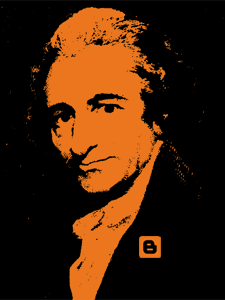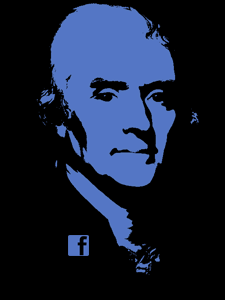Social media and the American experiment
by Brian T. Flanagan
 “The people want to bring down the regime.”
“The people want to bring down the regime.”
Thus goes the motto of the Arab Spring, a wave of revolutionary ferment arriving in more than a dozen countries, from the Atlantic, Mediterranean, and Red Sea coasts of Africa to the Arabian Sea and Persian Gulf.
The popular debate — engaged by the who’s who of Twitterati and American intellectual elite, including Clay Shirky and Malcolm Gladwell — has been on the impact of social media.
Beyond communication — i.e., we plan on Facebook, coordinate on Twitter, and show the world on YouTube — has social media caused light air, a strong gale force wind, or something more?
We find an answer in the 250-year-old sea change that began in Boston Harbor.
###
“Thirteen clocks were made to strike together,” John Adams wrote of the synchronized uprising by otherwise disunited American colonies. “A perfect mechanism,” he called it, “a singular example in the history of mankind.”
But what was the American revolution? Was it Washington’s war? Jefferson’s Declaration? Madison’s Constitution? For Adams,
The revolution was in the minds of the people … in the course of fifteen years before a drop of blood was drawn at Lexington.
And it was touched off by the era’s distinctive social media: the pamphlet.
Pamphlets of the American revolution were folded printer sheets, writes Bernard Bailyn, “stitched together loosely, unbound and uncovered….” They provided several advantages over competing media:
• Complete freedom of expression, according to George Orwell
• Speed and affordability, compared to books
• Space and global reach, compared to newspapers
Virtually anyone — at minimum cost and risk, maximum speed and reach — could “investigate premises, explore logic, and consider conclusions” for a broad national and even global audience.
Pamphlets were a social media in two ways.
They were in conversation with each other. They included “chain-reacting personal polemics: strings of individual exchanges — arguments, replies, rebuttals, and counter rebuttals….”
They were consumed in community. One copy would be read by an entire household, recited in the public square, distributed through a circulation society, or forwarded to family and friends — across town lines, colonies, and oceans.
Three famous examples are instructive.
 John Dickenson’s Letters from a Farmer in Pennsylvania acknowledged British authority in imperial affairs, but claimed American domestic sovereignty. Dickenson was republished across the colonies and in London, Dublin, and Paris.
John Dickenson’s Letters from a Farmer in Pennsylvania acknowledged British authority in imperial affairs, but claimed American domestic sovereignty. Dickenson was republished across the colonies and in London, Dublin, and Paris.
Thomas Jefferson’s A Summary View of the Rights of British America argued that colonists had created laws to promote happiness in their new context, and Parliament had no jurisdiction to change them. It established Jefferson’s reputation as a writer.
Thomas Paine’s Common Sense said that no island can rule a continent. He sold 500,000 copies in 25 editions within a year — that was one for every five people in the colonies. It’s easy to imagine virtually every American reading or hearing Paine’s words.
In all, 1,500 pamphlets were published between 1750 and 1783. They are widely credited as the cause of radical change in the minds and hearts of the people, and the American “religious, moral, political, and social” revolution that Adams described.
###
Yet, we need only recall the names of seven individuals to understand the limits of this popular revolution: George Washington, Benjamin Franklin, John Adams, John Jay, Thomas Jefferson, James Madison, Alexander Hamilton.
Imagine the moment of Independence.
Washington was commanding and Hamilton was serving in the field. Madison, 25-years-old, was in the Virginia state legislature. Franklin, Adams, Jay, and Jefferson were in the Continental Congress at Philadelphia.
These seven were leaders — not just thought leaders, but men of action.
Independence had been fiercely debated in congress for two months. It was in this debate that Adams earned his title “Atlas of Independence” in volley with opponents who thought the decision was premature, unwise, dangerous, or treasonous.
In June, Richard Henry Lee offered his resolution:
Resolved, that these United Colonies are, and of right ought to be, free and independent States, that they are absolved from all allegience to the British Crown, and that all political connection between them and the State of Great Britain is, and ought to be, totally dissolved.
Now, on July 2, 1776, congress was seated for the vote. New Hampshire voted yes. Rhode Island: yes. Massachusetts: yes. New York abstained. Connecticut: yes. New Jersey: yes. Pennsylvania, Delaware, Virginia, Maryland, North Carolina, South Carolina, Georgia: yes.
 We imagine 150 decibels of celebration: men cheering, rapping canes, clenching fists — waves of adrenaline and patriotism surging through the congress.
We imagine 150 decibels of celebration: men cheering, rapping canes, clenching fists — waves of adrenaline and patriotism surging through the congress.
For Adams, it was a moment of triumph. It was a defining victory. It was a culmination of his long education, his fierce determination, his months-long labor in Philadelphia’s summer heat.
It was an earth-shakingly historic moment.
And yet, by all accounts the delegates were overcome by silence and stillness. The air sucked out of the room.
Why?
Because it was a solemn decision, rife with peril, and with grave consequences for a new nation at war.
Two days later, congress pledged their lives, fortunes, and sacred honor. This was not hyperbole.
Franklin quipped, “We must hang together … else, we shall most assuredly hang separately.”
Washington, Adams, and Jay had served in the First Continental Congress. Washington, Adams, Jay, Franklin, and Jefferson served in the Second. Jefferson, Adams, and Franklin authored independence. Washington and Hamilton fought the war. Franklin, Adams, and Jay negotiated the peace at Paris. Washington, Franklin, Madison, and Hamilton wrote a new and unprecedented constitution, which was then preserved and protected by President Washington, Vice President Adams, Chief Justice Jay, Secretaries Jefferson and Hamilton, Congressman Madison.
These seven stepped forward time and again to serve. They risked all.
Our lesson is that the most important social media of the day — the pamphlet — was instrumental in changing hearts and minds. But it was no substitute for courageous leadership.
###
Reflecting on social media and the Arab Spring in the pages of Foreign Affairs, Clay Shirky wrote, “the potential of social media is mainly in their support of civil society and the public sphere — change measured in years and decades rather than weeks or months.”
Informed conversation — cheaper, faster, safer, and more dynamic than ever, thanks to social media — is the source of changing political opinion.
Responding to this point of view in The New Yorker, Malcolm Gladwell wrote, “Activism that challenges the status quo … is not for the faint of heart.” It’s not for acquaintances who “like” causes.
Change requires risk-taking men and women, and it requires energetic, strategic, and disciplined leadership.
Meaningful political change — in the founder’s time and ours — occurs where strong civil society meets the courageous leadership of a dedicated few. The product is a perfect storm and, we hope, a prudent recovery.
